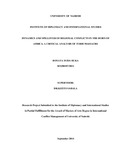| dc.description.abstract | The Turbi Massacre of 2005 is a conflict that just like other conflicts is not mono-causal
in nature. There are different causes that are responsible for the occurrence such as weak
government institutions, ethno-politics, marginalization and internationalization aspects
of a conflict. Another aspect is the resource based causes and pastoralists causes that are
evident in the Turbi Massacre, which was an event of underlying occurrences of crossborder
raids between Ethiopia and Kenya between the Gabra and Borana communities.
Massacres however have happened all over the world, from the German’s’final solution’
to kill certain groups of people during the Nazi regime to the Rwandan genocide and the
Wagalla Massacre. Indeed these massacres as is discussed in the study share different
characteristics such as politics of identity and poor governance as well as economic
deprivation or some degree of resource competition. In bid to examine the dynamics
surrounding the Turbi Massacre the study was guided by several objectives, to: examine
the root causes of Turbi Massacre, interrogate the impacts of Turbi Massacre, to examine
measures taken by the Kenyan Government to curb the conflict and also to recommend
options for sustainable peace and security in Northern Kenya. This objectives lead to two
hypothesis that suggest that, the Turbi Massacre was a consequence of government’s
inability to intervene the conflict promptly, and that, the Massacre adversely strained the
relationship between the Gabra and Borana Community in north eastern Kenya.
The study used both primary and secondary data collection. The primary being the Turbi
area of Marsabit where the massacre occurred, with the research design focused on
descriptive survey and a method of collecting information by interviewing or
administering a questionnaire to a sample of individuals. Target population covered the
conflicting communities especially Gabra-Borana within the study region. Other
secondary data was from published and unpublished academic and policy literature
relevant to the study. The study used the Primordialism theory which states ethnic
identities are historically rooted, deeply embedded in a people’s culture, which equally
applies to the warring communities of the Gabra and Borana where existence of natural
ties could not be disputed. The study therefore explores the different conflict
management mechanisms available and recommends as per their enhancement of the
effectiveness of conflict management policies and mechanisms | en_US |

